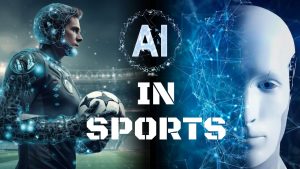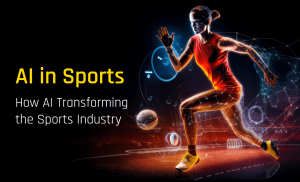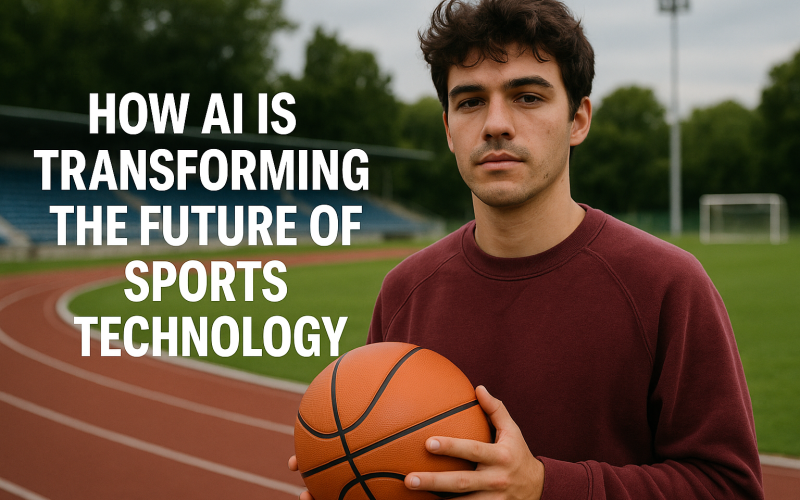Introduction
In recent years, artificial intelligence (AI) has made its mark in many industries, and sports are no exception. The future of sports technology is being shaped by innovations in AI that are improving training, performance tracking, and fan engagement. From more accurate data analytics to AI-driven coaching, this technology is transforming how athletes train, perform, and interact with their fans.
In this article, we will explore how AI is revolutionizing the world of sports. We’ll look at its impact on training, long term game strategy, and even how it’s changing the way fans experience sports. Let’s dive into the ways AI in sports is pushing the boundaries of what’s possible.
The Role of AI in Enhancing Athlete Performance

AI plays a crucial role in enhancing athlete performance by providing valuable insights and tools for improvement. Through wearable technology, AI can track an athlete’s movements, heart rate, and other metrics in real time. This data is then analyzed to optimize performance and identify areas where an athlete can improve. AI can also assist with goal setting, video analysis, and breaking down game footage to highlight key moments and strategies. By providing big data-driven feedback, AI allows athletes to train smarter, not harder, and make adjustments to their techniques to achieve better results. This helps athletes reach their full potential while minimizing the risk of overtraining or injury.
How AI is Impacting Sports Technology

1. Enhancing Athlete Training with AI
What is AI in Athlete Training?
AI is now being used to improve how athletes train. By analyzing large amounts of data collection, AI can identify strengths and weaknesses in an athlete’s performance. It provides coaches with insights on how to adjust training programs for better results. AI tools help athletes track their workout data, such as speed, strength, endurance, and biomechanics in real time.
Why It’s Important for Athletes
With AI, athletes get personalized feedback that helps them improve faster and more effectively. AI-powered tools provide real-time monitoring, so athletes can make immediate adjustments to their form or technique. This means they can avoid injuries and reach peak performance more quickly.
Examples of AI in Athlete Training:
- Smart Wearables: Devices like smart shoes or wristbands collect data and send it to apps that analyze performance.
- AI-driven fitness apps: Apps like Tonal or Freeletics offer personalized workout plans based on an athlete’s specific goals and progress.
- Motion-sensing technology: AI systems can monitor an athlete’s movement to provide valuable insights on form and technique.
2. AI for Performance Tracking and Analytics
What is AI in Sports Analytics?
AI is changing the way coaches and teams approach game strategy. Performance tracking tools powered by AI are used to analyze every aspect of a game, from player movements to ball placement. AI takes this data and processes it to offer advanced analytics, such as predicting player performance and evaluating game tactics.
Why It’s Important for Sports Teams
AI is helping coaches and sports teams make smarter decisions based on data-driven insights. By analyzing performance metrics like speed, stamina, and reaction time, AI helps optimize player performance. This is especially useful in sports like basketball, football, and soccer, where the tiniest adjustments can change the outcome of a game.
Examples of AI in Performance Tracking:
- Player Tracking Systems: AI-powered cameras can track player movements across the field or court in real-time.
- Data-driven Coaching: AI provides detailed game analysis, helping coaches develop more effective strategies based on opponent behavior and player stats.
- AI sports analytics platforms: Tools like STATS Perform and Second Spectrum use AI to provide coaches with advanced statistics on every aspect of a game.
3. AI’s Role in Injury Prevention and Recovery
How AI Helps Prevent Injuries
AI plays a crucial role in keeping athletes safe. By analyzing an athlete’s physical movements and monitoring their training habits, AI can predict potential injuries before they happen. It tracks muscle strain, fatigue levels, and form issues that may lead to injury. This allows coaches and trainers to make adjustments to the athlete’s regimen to prevent overuse injuries and help them recover faster.
Why Injury Prevention is Crucial
Injury prevention is key to maintaining an athlete’s career longevity. By using AI tools, coaches and teams can ensure that athletes aren’t pushing their bodies too hard, preventing injuries like stress fractures or tendonitis. AI also aids in faster rehabilitation by tracking the healing process and recommending recovery exercises based on real-time data.
Examples of AI in Injury Prevention:
- AI-powered wearable devices: These devices monitor muscle strain and joint movement to predict injury risks.
- Rehabilitation apps: Some apps use AI to provide personalized recovery exercises based on an athlete’s current condition.
4. AI in Sports Broadcasting and Fan Engagement
How AI is Changing Sports Broadcasting
AI is also transforming the way sports are broadcasted and consumed. In 2025, sports broadcasting will incorporate AI to enhance the viewing experience. For instance, AI can analyze a game in real-time and provide instant highlights, automatic commentary, or personalized viewing experiences tailored to the individual viewer’s preferences.
Why It Matters for Fans
AI is making sports more interactive and immersive for fans. With personalized content recommendations, fans can watch the moments that matter most to them. AI is also making it easier for fans to stay updated with live scores, game stats, and player performance without needing to watch the entire game.
Examples of AI in Fan Engagement:
- AI-driven streaming platforms: Platforms like DAZN and ESPN use AI to recommend personalized highlights and provide deeper insights into the game.
- Virtual coaches: Some sports apps provide real-time coaching tips based on the viewer’s game knowledge and interest.
5. AI and the Future of Smart Sports Equipment
What is Smart Sports Equipment?
In 2025, smart sports equipment will play a larger role in training and gameplay. These high-tech tools, powered by AI, include smart basketballs, intelligent tennis rackets, and AI-driven soccer balls. These pieces of equipment are capable of collecting data on how they’re used and providing feedback to improve an athlete’s skills.
Why It’s Important for the Future of Sports
Smart sports equipment makes it possible for athletes to receive immediate feedback while playing. These innovations can measure things like ball speed, trajectory, and accuracy, helping athletes improve their technique and performance.
Examples of Smart Sports Equipment:
- AI-powered tennis rackets: These rackets measure speed, spin, and accuracy to improve the player’s game.
- Smart soccer balls: Soccer balls that track how much force is applied, as well as ball spin and flight.
- Smart basketballs: These balls analyze shots, giving players real-time feedback on their performance.
The Future of AI in Sports Technology

The future of AI in sports technology looks incredibly promising, with new advancements expected to enhance almost every aspect of sports. In the coming years, AI is expected to become more integrated into the daily lives of athletes and sports teams. We may see AI being used to create virtual training environments, enhance live game broadcasts with real-time analytics, and even assist in developing new sports equipment that is tailored to individual athletes. As AI technology continues to evolve, we can expect it to become even smarter and more intuitive, making sports training, management, and fan experiences more interactive and data-driven. The future of AI in sports will likely push the boundaries of what’s possible, creating new opportunities for innovation and improvement.
Comparative Table: How AI is Transforming Sports Technology
| Technology | Impact on Sports | Example |
|---|---|---|
| AI in Athlete Training | Personalized workout plans, real-time feedback | Freeletics, Tonal |
| AI for Performance Tracking | Analyzes player movements, helps in game strategy | Second Spectrum, STATS Perform |
| Injury Prevention | Predicts and prevents injuries using motion sensors | Catapult, Whoop Strap |
| AI in Sports Broadcasting | Provides personalized content, automated highlights | DAZN, ESPN |
| Smart Sports Equipment | Tracks ball speed, accuracy, spin | Smart Tennis Racket, Smart Soccer Ball |
Conclusion
AI is undoubtedly transforming sports technology, making it more efficient, engaging, and smarter than ever. From enhancing training techniques to preventing injuries and improving fan experiences, AI is helping athletes, coaches, and fans experience sports in entirely new ways. As we move into 2025, the influence of AI in sports will continue to grow, providing even more opportunities for innovation in both the professional and recreational sports worlds.
As an athlete, coach, or fan, it’s exciting to see where AI will take sports technology in the coming years. Keep an eye on these advancements as they continue to shape the future of sports.
Call to Action
Ready to embrace the AI revolution in sports? Explore the latest in sports technology and performance tracking today! Visit our website for more insights and updates on AI innovations in sports.












